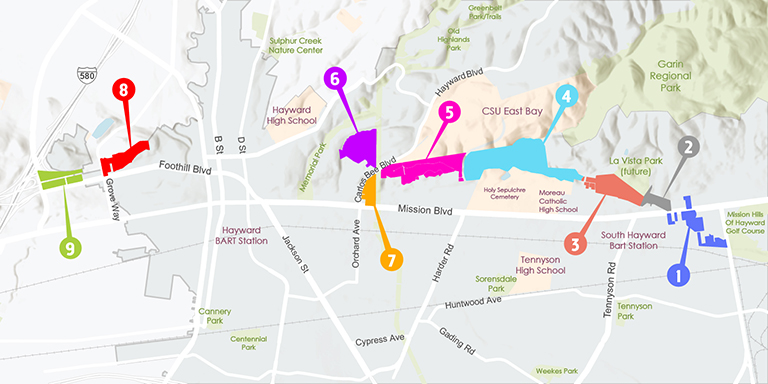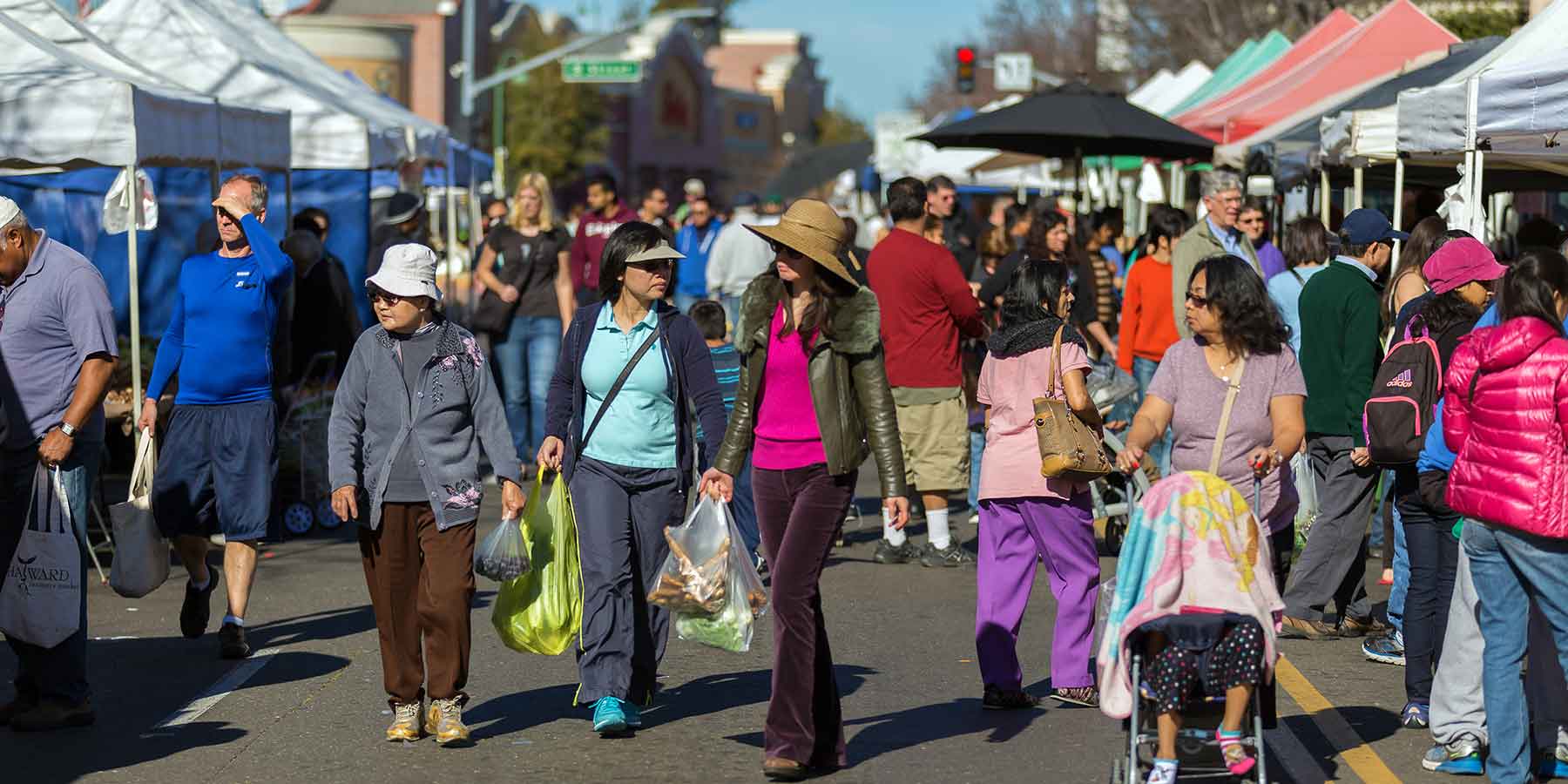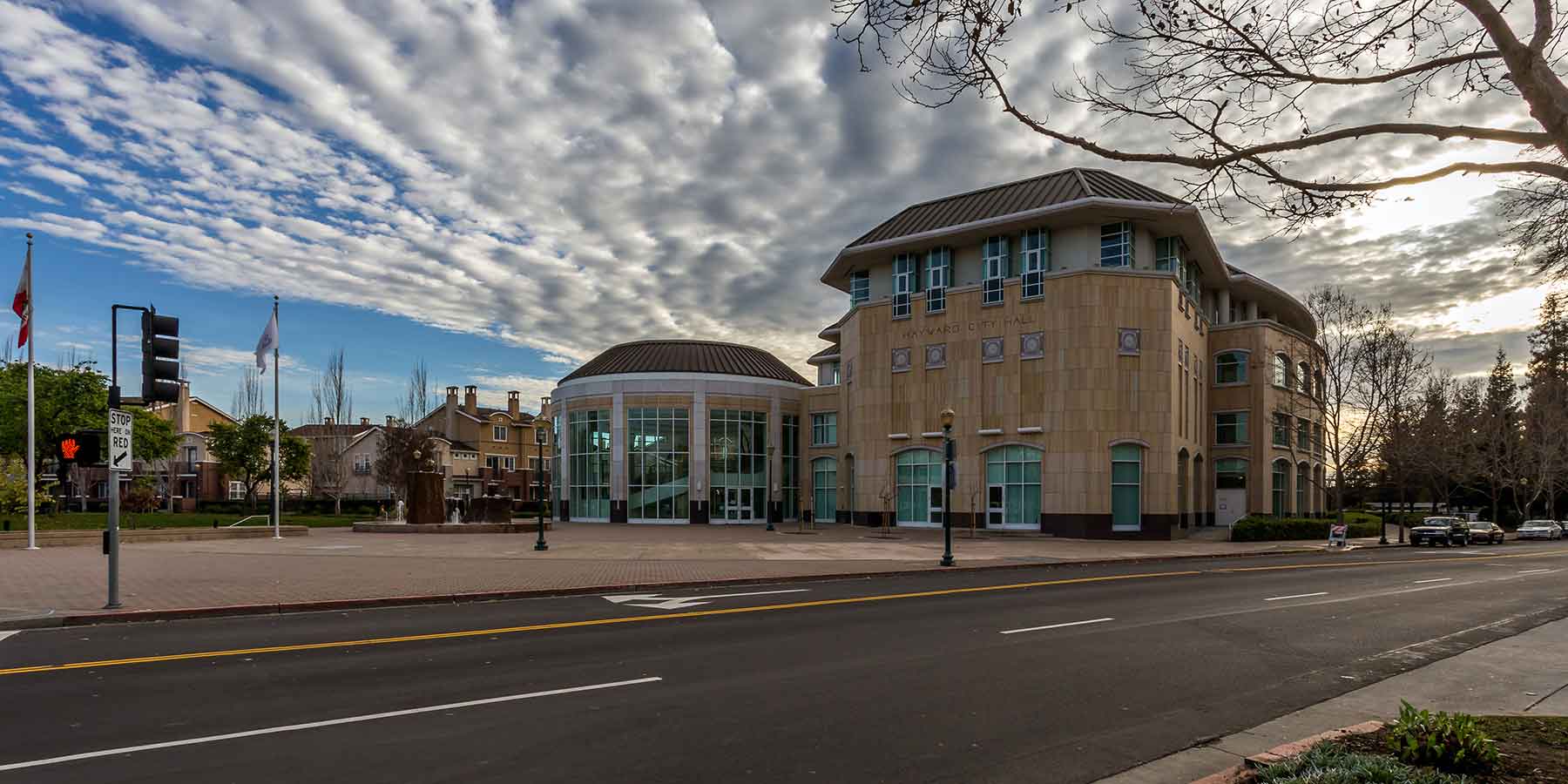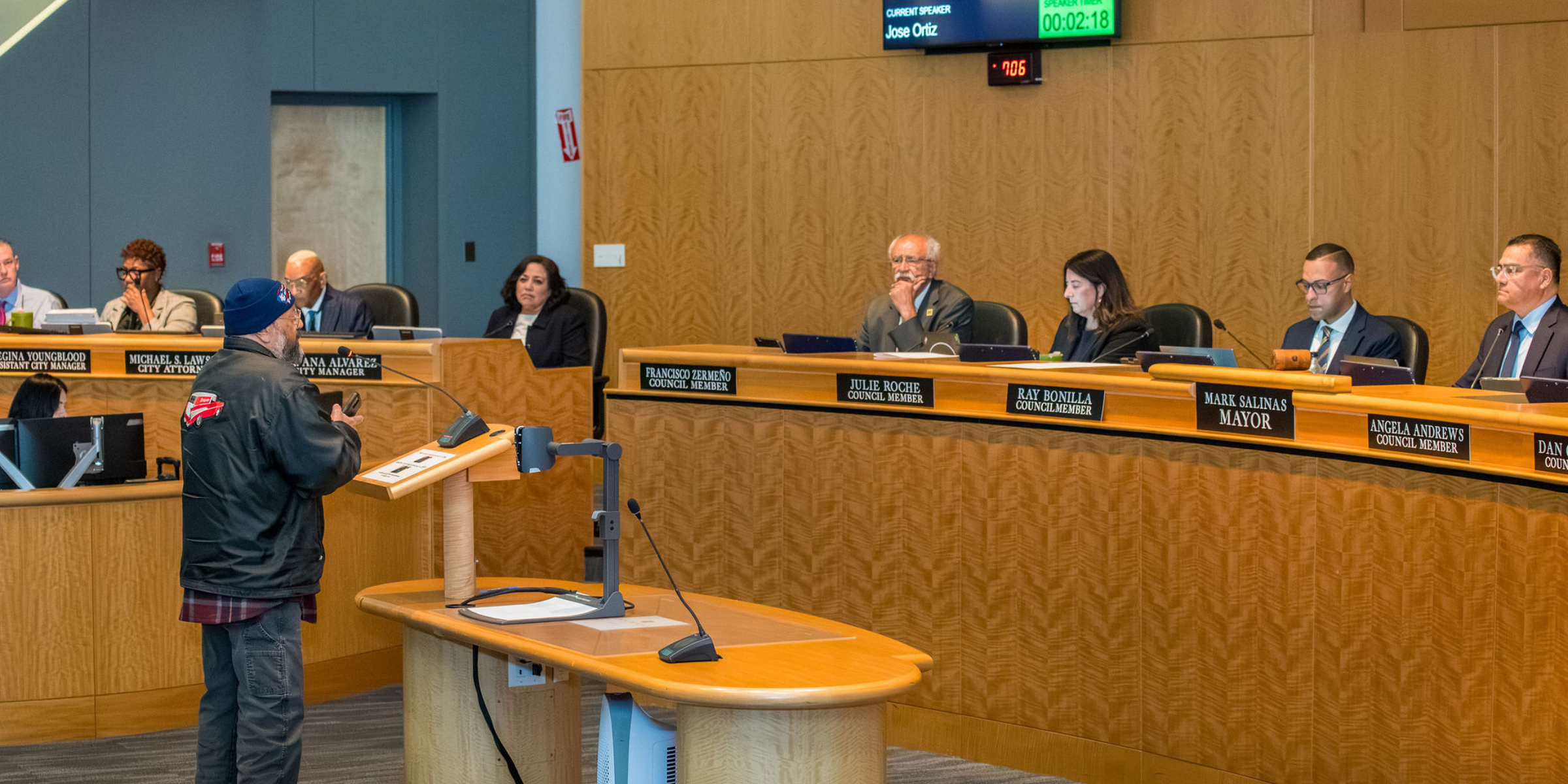California State Route 238 Corridor Lands
The City of Hayward is leading the planning and disposition for development of 10 parcel groups of surplus property pursuant to a Purchase and Sale Agreement with the California Department of Transportation (Caltrans).

Background
In the mid-1960s, the California State Department of Transportation (Caltrans) purchased more than 400 parcels of property for construction of a 14-mile 238 Corridor Bypass Freeway to run through the City of Hayward and parts of unincorporated Alameda County.
In 1971, a lawsuit, filed in federal court on behalf of residents to be displaced by the freeway construction, blocked the project. Caltrans subsequently abandoned the freeway plan.
In 1982, state legislation was passed to allow Hayward and other local jurisdictions—working through the Alameda County Transportation Authority—to develop alternative strategies for relieving traffic congestion in Central Alameda County. The legislation called for these Local Alternative Transportation Improvement Program projects to be funded from proceeds from the sale of properties that had been accumulated by Caltrans for the 238 Bypass Freeway.
In 2009, then- Gov. Arnold Schwarzenegger directed Caltrans to sell all property not needed for existing LATIP projects. The directive led to negotiations and a legal settlement between Caltrans, the City and residential tenants residing on the 238 Bypass Corridor properties. Under the settlement, every tenant household living in the Corridor as of Jan. 1, 2010, received a “lump sum stipend,” which was calculated using Caltrans policies with consideration given to length of tenancy, household size and income. The lump sum stipends were comprised of a “relocation payment” and “moving stipend.”
Additionally, several of the Caltrans 238 properties were sold to their Corridor tenants through a City-assisted first-time homebuyer program.
Lastly, new residential development in the Corridor was required to include at least 237 new low-income housing units through application of the city’s inclusionary Affordable Housing Ordinance. And, tenants of the Caltrans properties were to be given occupancy preference where possible and allowable when new below-market housing is constructed in the Corridor.
In 2011, following formal adoption of the settlement, the City approached Caltrans with a proposal to allow the City to take responsibility for the disposition and development of the remaining Caltrans-owned property. After initial disinterest, Caltrans agreed to negotiate, and eventually a Purchase and Sale Agreement was approved by the City Council and the California Transportation Commission (CTC) in January 2016.
The Agreement with Caltrans consists of the following major elements and benefits:
- The City may buy from Caltrans 10 different parcel groups for a six-year period that expires in January 2027.
- Properties that have not been resold by the City to developers can be returned to Caltrans without penalty
- During the six-year period, the City will pre-plan and partially entitle each parcel group to ensure maximum value and conformance with city land-use plans, policies and vision.
- An appraisal process shall determine property values. These amounts will be paid to Caltrans. If the City can negotiate a higher land value on resale to developers, due to its preplanning and entitlement process, the excess proceeds will be allocated to the City.
- The City will require parcels to be developed and not resold for speculation.
- The City has control over the public input process on proposed development plans.
- The City can plan the appropriate infrastructure upgrades needed to support the sale of the combined parcel groups, and establish infrastructure funding districts as appropriate.
Parcel Groups
Groups 1 & 10 - William Lyon Homes (SOHAY):
The City Council approved a 472 mixed-income, multi-family rental and for-sale townhome-style unit and retail development proposal from William Lyon Homes in May 2018. This project was the subject of a Purchase and Sale Agreement between the City and William Lyon Homes. It also included the acquisition of parcels owned by the Alameda County Flood Control District and the Bay Area Rapid Transit District as well as a land swap between the City and the Hayward Area Recreation and Park District.
Group 2 - True Life Companies:
The City entered into an Exclusive Negotiating Rights Agreement with the True Life Companies in April 2018. The True Life Companies proposal contemplates the development of a mixed-use 190-unit development.
Groups 3 & 4 - Eden Housing:
The City Council approved the issuance of Requests for Proposals for Parcel Groups 3 & 4 in April 2018. Following this process, the City entered into an Exclusive Negotiating Rights Agreement (ENRA) with Eden Housing and the Pacific Companies for the acquisition of both parcel groups in July 2018.
Eden Housing and the Pacific Companies proposal contemplates the development of mixed income housing and a charter school primarily within the boundaries of Parcel Group 3.
Group 5 - Bunker Hill:
Group 6 - Quarry:
Group 7 - Carlos Bee/ Mission:
The City entered into an Exclusive Negotiating Rights Agreement with BMODDRE2, LLC in October 2018. Their proposal contemplates the development of a new, brand name auto dealership.
Group 8 - Grove Way:
The City is currently working with consultant Design Workshop to develop a Route 238 Master Development Plan. This process will allow the City to facilitate the public input process, plan associated infrastructure upgrades, and conduct the environmental analysis needed. Upon completion of the Master Development Plan, the parcel groups will be offered for sale through a Request for Proposals (RFP) process to evaluate specific development plans submitted. Additionally, the City is collaborating with Alameda County in the development of conceptual proposals.
Group 9 - Apple/Oak:
The City is currently working with consultant Design Workshop to develop a Route 238 Master Development Plan. This process will allow the City to facilitate the public input process, plan associated infrastructure upgrades, and conduct the environmental analysis needed. Upon completion of the Master Development Plan, the parcel groups will be offered for sale through a Request for Proposals (RFP) process to evaluate specific development plans submitted. Additionally, the City is collaborating with Alameda County in the development of conceptual proposals
Frequently Asked Questions
How long will the Master Plan process take?
The design team has already begun gathering information and meeting with staff and members of the public. The tentative project schedule estimates that the Master Development plan will be presented to City Council for their review in the Fall of 2018.
Will the public be involved in the master planning development process?
Public involvement is an essential component of the development plan process. The design team has incorporated community engagement to each stage of the project process including, but not limited to, public hearings, community meetings, and conversations with stakeholders.
What are the City’s goals with this development?
By facilitating the design and sale of these parcels, the City of Hayward hopes to ensure that the development plans conform to the City’s current land use policies and overall vision. This level of oversight will allow the City to integrate key strategic priorities while increasing the city’s tax revenue base through the development and sale of these properties.
Will there be affordable housing?
The development plan will adhere to the City’s affordable housing ordinance and provide a mix of housing stock, per the City Council’s Strategic Initiatives.
Who will be the developer for these projects?
Selecting developers for the parcels will be done through a Request for Proposal (RFP) process once Council has approved the overall Master Development Plan.
How will this development affect the adjacent homeowners?
Some of the parcel groups have homes that are publicly owned next to homes that were previously sold by Caltrans to private owners. The homes sold to private owners, outside of the City’s negotiated Purchase and Sale Agreement with Caltrans, will remain with the current homeowner and are not included in the Master Development plan
Documents
Jun. 4, 2024 - City Council
Adopt a Resolution Authorizing the City Manager to Execute the Eighth Amendment to the Purchase and Sale Agreement with Caltrans for Transfer and Development of State Highway 238 Bypass Properties that Extends the Deadline for the City to Dispose of the Properties by Five Years from 2027 to 2032
May 7, 2024 - City Council
Adopt a Resolution in Support of the College Heights (formerly Bayview Quarry Village) Concept Project - Parcel Group 6
Feb. 20, 2024 - City Council
Sale of Parcel Group 8 for Development of Affordable Housing: Adopt Two Resolutions 1) Approving the Government Code Section 52201 Summary Report for the Project; and Authorizing the City Manager to Execute the First Amendment to the Disposition, Development, and Loan Agreement with RCD GP IV, LLC and Parcel Group 8, L.P. for Transfer of Specified City Owned Properties and for the Development of Housing and Making Specified Findings in Association with Government Code Section 65913.4 Exemption from the California Environmental Quality Act; and 2) Authorizing the City Manager to Execute an Agreement with the Developer Associated with the State of California Affordable Housing and Sustainable Communities (AHSC) Program
Jun. 27, 2023 - City Council
Adopt Resolutions Rejecting All Bids for the La Vista Park Project and Approving Plans and Specifications and Call for Bids for the La Vista Park - Keyways Grading Project, Project No. 06914, and Authorizing the City Manager to Execute Amendment No. 2 to the Professional Services Agreement with SurfaceDesign, Inc. - Parcel Group 3
Nov. 15, 2022 - City Council
Adopt a Resolution Authorizing the City Manager to Negotiate and Execute the First Amendment to the Disposition and Development Agreement with Trumark Properties, LLC to Allow Deferral of the Excess Purchase Price Above the Caltrans Base Purchase Price Until Issuance of Certificates of Occupancy for the Transfer of Parcel Group 5, Bunker Hill RECOMMENDATION
Nov. 1, 2022 - City Council
Adopt a Resolution: (1) Authorizing the City Manager to Negotiate and Execute the First Amendment to the Disposition and Development Agreement with Eden Housing, Pacific West Communities, and Strategic Growth Partners and Other Affiliated Entities for Transfer of Specified City Owned Properties within Parcel Group 3 and Amendments to Exhibits Attached Thereto including the Restrictive Use Covenant Agreement; and (2) Approving Modifications to the Parcel Group 3 Affordable Housing Plan (Planning Application #202001594)
Sept. 20, 2022 - City Council
Adopt a Resolution Authorizing a Grant Deed for the "MAE Parcel" of Tract 8428, SoHay, to the Hayward Area Recreation and Park District - Parcel Group 1
Jun. 28, 2022 - City Council
Sale of Parcel Group 8 for Development of Affordable Housing: Adopt a Resolution Approving the Government Code Section 52201 Summary Report for the Project; and Authorizing the City Manager to Negotiate and Execute a Disposition, Development, and Loan Agreement with RCD GP IV, LLC and Parcel Group 8, L.P. for Transfer of Specified City Owned Properties and for the Development of Housing and Making Specified Findings in Association with Government Code Section 65913.4 Exemption from the California Environmental Quality Act
Mar. 24, 2022 - City Council
Proposed Development of a New Residential Subdivision with 74 New Single-Family Homes and Eighteen Accessory Dwelling Units and Related Site Improvements, Including Construction of a Segment of the Foothill Trail and a New Roadway Connector From Bunker Hill Boulevard to Carlos Bee Boulevard, Requiring Approval of Zone Change and Tentative Tract Map Application No. 202003054 for Caltrans Parcel Group 5. Trumark Properties LLC (Applicant), City of Hayward (Owner).
Mar. 15, 2022 - City Council
Approval of Final Map for Tract 8502, a 15 Lot Subdivision for Condominium Purposes at 29212 Mission Boulevard to Allow the Construction of 130 Condominium Units, 10,800 Square Feet of Ground Floor Commercial Space, Open Space Areas, and Related Site Improvements; Applicant/Owner: Hayward SoMi, LLC., Application No. 202100251 RECOMMENDATION - Parcel Group 2
Feb. 8, 2022 - City Council
Adopt a Resolution: (1) Declaring Specified City-Owned Properties Associated with the Former 238 Bypass Project Exempt Surplus Lands; and (2) Declaring Parcel Group 4 as Surplus Lands Pursuant to Government Code Section 54221
Dec. 14, 2021 - City Council
Adopt a Resolution: (1) Finding a Statutory Conflict between the Local Alternative Transportation Improvement Program Statutes (Government Code 14528.6 and 14528.65) and the Surplus Lands Act; and (2) Declaring City-Owned Properties Associated with the Former 238 Bypass Project, and Subject to the 2016 Purchase and Sale Agreement between the State of California Department of Transportation and the City of Hayward, as Exempt Surplus Lands
Dec. 14, 2021 - City Council
Adopt a Resolution Authorizing the City Manager to: (1) Negotiate and Enter into an Easement Agreement with California State University East Bay for a Roadway and Utility Connection to Carlos Bee Boulevard from Former Caltrans Property Parcel Group 5; and (2) Appropriate $295,668 from Fund 411 for the Parcel Group 5 Project in the Route 238 Settlement Administration Project 05014
Oct. 19, 2021 - City Council
Sale of Parcel Group 3 for Development of New Affordable Housing and a School: Adoption of Resolutions (1) Declaring City-Owned Properties Generally Located between Tennyson Road and Broadway Street as Exempt Surplus Lands; and (2) Approving the Government Code Section 52201 Summary Report for the Project; and Authorizing the City Manager to Negotiate and Execute a Disposition and Development Agreement with Eden Housing, Pacific West Communities, and Strategic Growth Partners for Transfer of Specified City Owned Properties; and Amendment of the Parcel Group 3 Affordable Housing Plan (Planning Application #202001594), Consistent with Prior California Environmental Quality Act Determinations (Report from Assistant City Manager/Development Services Director Ott)
Oct. 14, 2021 - Planning Commission
Preliminary Review of an Application to Construct 298 Residential Units, a Public Park, a Portion of the Hayward Foothill Trail, and Various Site and Frontage Improvements for Parcel Group 6 (Former 238 Parcel), on an Approximately 29.8-acre Site Located at Overlook Avenue and Carlos Bee Boulevard (Assessor Parcel No. 445-0180-001-00) Requiring Site Plan Review and Tentative Tract Map 8604. Application No. 202101471; Steven Jones for Integral Communities (Applicant) on behalf of The City of Hayward (Owner).
Jun. 15, 2021 - City Council
Adopt a Resolution Authorizing the City Manager to Negotiate and Enter into an Amendment to Extend the Exclusive Negotiating Rights Agreement with Eden Housing Inc. and Pacific Companies (Parcel Groups 3 and 4)
Jun. 1, 2021 - City Council
Adopt a Resolution Authorizing the City Manager to Negotiate and Enter into an Amendment to Extend the Exclusive Negotiating Rights Agreement with Trumark Properties (Caltrans Parcel Group 5)
Dec. 8, 2020 - City Council
1032 Central Blvd Property Disposition: Adopt a Resolution Making Findings to Designate the 0.24-Acre City Owned Parcel Located at 1032 Central Boulevard as Surplus Property and Begin the Surplus Property Process Consistent with the Surplus Property Land Act (Report from Deputy City Manager Ott) - Parcel Group 5
Oct. 6, 2020 - City Council
Adopt a Resolution Authorizing the City Manager to Negotiate and Execute an Agricultural Lease Agreement with Virgil Robertson for 20 Acres on Parcel Group 4 Generally Situated on Undeveloped Land between Harder and Tennyson Roads RECOMMENDATION
Sept. 29, 2020 - City Council
Adopt a Resolution Authorizing the City Manager to Enter into an Exclusive Negotiating Rights Agreement with Integral Partners Funding, LLC, for the Proposed Development of Parcel Group 6: Carlos Bee Quarry
Sept. 15, 2020 - City Council
Adopt Resolutions to Memorialize that the Provision of Affordable Housing and an Expansion of Carlos Bee Park Will Satisfy the Park and Affordable Housing Dedications for Former Caltrans 238 Parcel Group 8 in order to Secure Caltrans Authorization to Subdivide Parcel Group 8 and Authorize the City Manager to Enter into an Exclusive Negotiating Rights Agreement with Resources for Community Development (RCD), a California Nonprofit Public Benefit Corporation, for the Proposed Development of the Affordable Housing Segment of Parcel Group 8 Generally Situated along Grove Way between Bridge Court and Foothill Boulevard
Sept. 15, 2020 - City Council
Adopt a Resolution Authorizing the City Manager to Enter into the Seventh Amendment to the Purchase and Sale Agreement between the State of California Department of Transportation and City of Hayward for the 238 Excess Properties to Extend the Term of Sale for Five Additional Years to January 2027
Jun. 23, 2020 - City Council
Hayward Municipal Code: Adopt an Ordinance Amending Chapter 10, Article 1 (Zoning Ordinance) of the Hayward Municipal Code Rezoning Certain Property to General Commercial in Connection with Zone Change Application No. 202000605 to Accommodate the Future Development of Parcel Group 9
Jun. 16, 2020 - City Council
Route 238 Parcel Group 9: Proposal to Rezone Former Caltrans Property known as Rte. 238 Parcel Group 9 Located at the Intersection of Apple Avenue and Oak Street (Assessor Parcel Nos. 415-0160-052-00, & 415-0170-037-00) from High Density Residential (RH) and Commercial Office (CO) to General Commercial (CG), Requiring Approval of Rezoning Subject to an Addendum of the Hayward 2040 General Plan EIR per the California Environmental Quality Act (CEQA) Section 15164; City of Hayward (Applicant/Property Owner; Application No. 202000605) (Report from Development Services Director Simpson)








